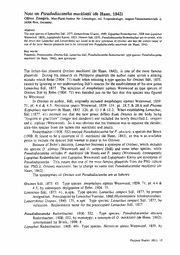
Note on Pseudodiacantha macklottii (de Haan, 1842) PDF
Preview Note on Pseudodiacantha macklottii (de Haan, 1842)
Note on Pseudodiacantha macklottii (de Haan, 1842) Oliver ZomprO) Max-Plank-Institul fill Limnologie, AG Tropenokologie, August-Thienemannstra^e 2, 24306 Pliin, Germany. Abstract The type species ofLamachusStill, 1877, Lamnrchinus Uvarov, 1940, LopaphusRedtenbacher, 1908(noiLopaphus Westwood, 1859), LopaphodesKarny. 1923. OrxinesSiAl, 1875, PseudodiacanthaRedtenbacher are reviewed, with the result that Lamachus and Lamnrchinus are found to be new synonyms ofOrxines and that the correct name of one of the most famous phasmids has to be corrected into Pseudodiacantha macklottii (de Haan, 1842). Key words Phasmida, Phasmatodea, Onrme^Stiil.Zia/nflchicfStAl, Pseudodiacantha Redtenbacher, typespecies,Pseudodiacantha macklottii (de Haan, 1842), new synonyms. The lichen-iike phasmid Orxines macklottii (de Haan, 1842), is one of the most famous phasmids. During his research on Philippine phasmids the author came across a striking mistake which Rehn (1904: 71) made when selecting a type species for Orxines StAl, 1875, caused by ignoring or not understanding Stal’s reasons for the establishment ofhis new genus Lamachus Si21, 1877. The selection of Anophelepis xiphias Westwood as type species of Orxines Stal by Rehn (1904: 71) was founded just on the fact that this species was figured by Westwood. In Orxines its author, St£l, originally included Anophelepis xiphias Westwood, 1859: 71, pi 4.4 & 4.5. Necroscia zeuxis Westwood, 1859: 151, pi. 28.5 & 28.6 and Phasma (Lopaphus) macklottii de Haan, 1842: 126, pi. 11.1 & 11.2. When establishing Lamachus, Stal (1877: 41) pointed out that the new genus differs from Orxines in the body being "longiore et graciHore" (longer and slenderer) and included the newly described L. semperi and L. xiphias (Westwood). So it was obvious that his intention was to separate the slender, stick- ike species from the lichen-like macklottii and zeuxis. 1 Redtenbacher (1908: 552) erected Pseudodiacantha for P. obscura a species that Brock , (1998: 8) found to be a synonym of O. macklottii (de Haan, 1842), so this is an available genus to include the species Stal wanted to place in his Orxines. Because of Rehn’s decision, Lamachus becomes a synonym of Orxines which includes , the species O. xiphias (Westwood) and O semperi (Stal) and some other species, while . Pseudodiacantha includes P. macklottii (de Haan) and P. zeuxis (Westwood): consequently Lopaphus Redtenbacher (not Lopaphus Westwood) and Lopaphodes Kamy are synonyms of Pseudodiacantha. This means that one of the most famous phasmids from the PSG culture list: PSG 2, Orxines macklottii, has to change its name into Pseudodiacantha macklottii (de Haan, 1842). The synonymies of Orxines and Pseudodiacantha are as follows: Orxines Stal, 1875: 43. Type species: Anophelepis xiphias Westwood, 1859: 71, pi. 4.4 Sc 4.5, by subsequent designation of Rehn, 1904: 71. Lamachus Stal, 1877: 41, n.syn, Type species: Lamachus semperi Stal, 1877, by present designation. Preoccupied by Lamachus Foerster, 1868 (Hymenoptera: Ichneumonidae). Lamarchinus Uvarov, 1940: 175, n.syn. Type species: Latnachas semperi Si&l, 1877, by indication. Replacement name for the preoccupied Lamachus Stil, 1877. Pseudodiacantha Redtenbacher, 1908: 552. Type species: Pseudodiacantha obscura Redtenbacher, 1908: 552, by monotypy; a synonym of O. macklottii (de Haan, 1842), synonymised by Brock, 1998: 8. Lopaphus Redienbacher, 1908: 491. Type species: Necroscia zeuxis Westwood, 1859, by Phasmid Studies. 10(1): 15 , OliverZompro monotypy. Preoccupied byLopaphus Westwood, 1859: 99 (Phasmatodea), replaced by Lopaphodes Kamy, 1923: 241. Lopaphodes Kamy, 1923: 241 (Replacement name forLopaphusRedtenbacher (notLopaphus & Westwood). Type species: Necroscia zeuxis Westwood, 1859: 151, pi. 28.5 28.6, by original designation. Synonymised erroneously with Orxines Stal by Gunther, 1934: 530. References Brock, P.D. (1998) Listoftype specimensofstick-insects inthe Zoologisch Museum, Universiteit van Amsterdam. Phasmid Studies, 7(1): 6-10. Haan, VV.de. (1842) Bijdragen tot de kennis der Orthoptera. In: Temminck, C.J.: Verhandelingen Zoologie vol. 2: 95-138. Karny, H.H. (1923) Zur Nomenklatur der Phasmoiden. Treubia, 3(2): 230-242. Redtenbacher, J. (1908) Die Insektenfamilie der Phosmiden. Ill. Phasmidae Anareolatae (Phibalosomini, Acrophyllini, Necrosciini). Leipzig. Rehn,J.A.G. (1904)StudiesintheOrthopterousfamilyPhasmidae. ProceedingsoftheAcademyofNaturalSciences, Philadelphia, 56: 38-107. Still, C. (1875) Recensio Orthopterorum. Revue critique des Orthopteres dScrits par Linn£, de Geer ei Thunberg. P.A. Norsiedt & Soner, Stockholm. Still, C. (1877) Orthoptera nova ex insulis Philippinis. OJversigt afKongliga Vetenskaps-Akademiens Handlingar, JO: 33-58. Uvarov, B.P. (1940)Twenty eightnewgeneric namesinOrthoptera. AnnalsandMagazineofNaturalHistory (11)5: 173-176. Westwood, J.O. (1859) Catalogue ofthe Orthopterous insects in the collection of the British Museum. Part l. Phasmidae. British Museum, London. Phasmid Studies. 10(1): 16
